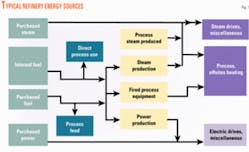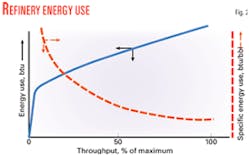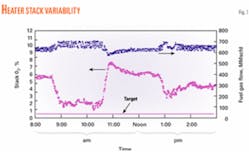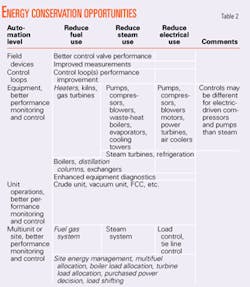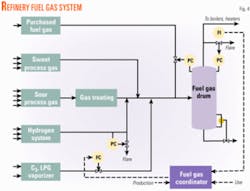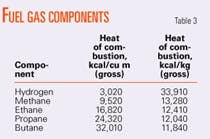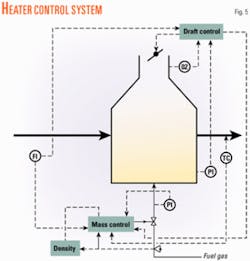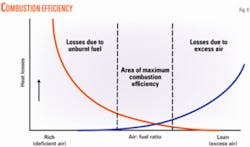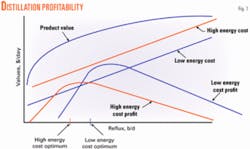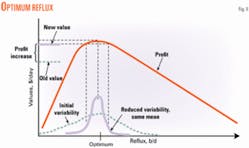Advanced automation can significantly reduce energy use in all areas of a refinery including process units, offsite units, and utilities. Some of these savings are possible with no investment-only a change in normal operating procedures. In other cases, improvements to online analyses and improved control action are justified.
Energy is the single largest controllable cost for most refineries, often comprising more than 50% of non-crude operating costs. Incremental fuel is normally natural gas; the recent rise in prices has caused most refineries to look even more closely at energy use.
Real-time modeling and monitoring of the energy use in plants also permits refiners to make allocation decisions much more frequently and accurately, often resulting in substantial savings. This article summarizes the results from many plants to provide guidance to refinery staff on likely areas for savings.
A systematic evaluation methodology identifies energy-reduction opportunities and the technology required to achieve them.
Energy costs
In 1999 and many years earlier, natural gas prices were typically about $2/Mcf. Starting in 2000, there has been both increased volatility and higher average prices due to increased demand in the US without commensurate increases in supply. Spot prices of $12-13/Mcf have been recently quoted for residential gas due to a sharp price spike, although longer-term industrial contracts are lower.
For the average US refinery, energy costs are the second-largest cost component after crude and intermediate products. Overall equivalent energy use is typically 500-700,000 btu/bbl, which leads to marginal energy costs of $4-7/bbl when natural gas is at $8-10/Mcf.
A 10% reduction in net energy use, at constant other costs, will therefore lead to an increase in refinery net margin of 40-70 ¢/bbl. This makes energy savings an obviously important topic in refinery cost control.
The theoretical minimum energy use for a refinery, if there is perfect heat recovery, is about 60,000 btu/bbl,1 which indicates there should be a large practical potential for reduced energy use.
To evaluate opportunities for savings, one must initially look at the overall site energy balance and the major consumers of energy. Refineries have relatively complicated utility systems with many different fuels and utilities and many sources and users (Fig. 1).
Internally generated fuel is the largest energy source, which is supplemented with additional purchases of fuel, generally natural gas, and possible purchases of supplemental electricity and steam. Steam and electricity are also produced internally.
There is considerable variation in the percentage of electricity produced on site; the overall North American industry average is about 33%. Direct process use refers primarily to the generation of coke in the FCC, the use within this unit for heating the feed to reactor conditions and providing the required endothermic heat of reaction. The process feed box on the purchased fuel line reflects the common use of natural gas as feed to a hydrogen plant.
According to the US Department of Energy, the average US refinery energy inputs are approximately:2
• Internal fuel, 64%.
• Purchased fuel (natural gas), 25%.
• Purchased power, 10%.
• Purchased steam, 1%.
Because natural gas is normally the marginal supply source, a decrease in total energy use results in less natural gas use with the associated savings.
Table 1 shows the distribution of energy use by process unit in the typical US refinery.3
This table does not include offsite units or use for ancillary areas such as cooling towers and water treating. The column percentages are of total process refinery use for the specified energy source. Total primary use is based on conversion of steam and power use to their fired fuel equivalents at standard conversion efficiencies. Negative signs indicate that the unit is a net producer.
The largest energy users are combustion furnaces for the production of power and steam and the heat required for separation processes, primarily distillation. For distillation processes, including crude distillation, heat is provided directly from fired heaters or reboilers or indirectly via steam reboilers. Other large users are gas compressors (and air blowers) on the FCC, reformer, hydroprocessing units, and other units.
For automation to reduce energy use significantly, the key targets are improved operation of central power and steam production, improved fired heater operations, and improved control of distillation and fractionation.
There are many alternate investments that can increase energy efficiency. Process modifications to improve energy recovery or reduce energy use, perhaps based on pinch analysis, are often effective. New heat exchangers may be added. The replacement of older, less-efficient equipment with newer equipment is another option. Simply adding additional insulation can be worthwhile. Cogeneration facilities to balance power and steam demand also continue to be popular investments.
After these investments have been made, however, one must still operate the plant in the most efficient way possible and maintain the equipment so that the efficiency does not deteriorate. These subjects are the focus of this article.
During 1975-85 there were many published articles on potential modifications to control systems to save energy. Many of the suggestions in these commentaries are still relevant today and a review is recommended. Shinskey provides a partial summary.4
Reducing energy use typically reduces NOx and other emissions from the refinery; this is more and more important in current refinery operations.
Operational energy use
Operating conditions vary widely in a given refinery. Different crudes, blends of crudes, and intermediates are processed. Overall production rates and the relative amounts of the different products change.
These variations cause individual process unit rates and operating conditions to change. The effects on the energy requirements for the refinery are twofold. The demand for the individual energy sources-fuel, steam, and power-varies significantly. Also, the composition of the internally generated fuel varies as the production from different sources within the refinery changes.
If overall energy use in an individual process unit is evaluated vs. throughput, a graph such as Fig. 2 is a typical result. There is a large initial component at low feed rates.
At higher rates, energy use is typically proportional to throughput, often linearly, but occasionally following more of a quadratic form. This means that energy use per unit feed is nonlinear (Fig. 2). Specific energy use (energy/bbl of feed) is higher at low capacity than at high capacities.
The further implication is that an evaluation of unit energy use must be corrected to a standard feed rate, a standard feed composition, and a standard severity of operation for efficiency calculations.
With these conditions it is common to observe significant variability in individual equipment operations.
Fig. 3 shows fuel-gas flow and stack oxygen measurements for a relatively simple heater used as a reboiler on a debutanizer column. Changes in debutanizer feed and fuel-gas quality cause substantial variations in operations and restrict the unit’s ability to operate close to minimum energy limits.
Energy conservation
There are many different automation improvements that can decrease energy use.
Table 2 shows a partial summary of possible automation improvements grouped by the level of automation and the energy source most affected. At the field-device level, measurement elements and final control elements such as valves or variable-speed motors are included.
The next level includes improvements to control loops and their performance. Better control of individual equipment items such as distillation columns, boilers, and heaters is at the next-highest level. Improved operation of a process unit within the refinery such as a crude unit or vacuum unit is listed next.
At the highest level are multi-unit or site-wide improvements in energy management. Investment requirements are higher at the top of Table 2.
These automation improvements reduce energy consumption through different methods, some reducing demand and others optimizing the supply:
• A direct reduction in equipment energy use or cost at equivalent equipment load due to changes in control strategy or implementation. For example, it may be possible to maximize the use of a low-valued fuel in a heater that has multiple fuel choices.
• Reduced process variability resulting from better control reduces energy through two mechanisms. If there are operating constraints that limit minimum energy use, reduced variability permits operation, on average, closer to the limit with subsequent average energy savings. In addition, many process equipments have used curves that directly reward reduced variability with energy savings without any change in average operating conditions.
• Better control also permits coordinated control of process operations when feed rates and other conditions change. One of the major reasons for excessive energy use in plants is that energy set points are not often changed but are left at a level that supports the highest feed rate and most severe operation.
• Advanced automation systems evaluate alternatives and provide guidance on the current, best method of operation. Operating a major complex such as a refinery involves many decisions, made daily or hourly, that affect energy use. These decisions are often made on an ad hoc basis with limited consideration of the effects outside the equipment in question or the process unit itself.
• More effective equipment maintenance can ensure that it operates at a high energy efficiency more often and also avoids failures that increase energy use. Improved performance monitoring and enhanced diagnostics to support this more effective maintenance is discussed in previous papers.5 6
Table 2 shows several items in italics, which are discussed in the following sections. These have some of the largest potential improvements for energy use.
Fuel-gas system control
The heater data in Fig. 3 shows the large influence that variability in the fuel-gas system can have on the operation of fired equipment throughout the plant. Although controls on the equipment should be improved to compensate for the changes, eliminating or reducing the variability is even better.
Fig. 4 shows a typical refinery fuel-gas system. There are multiple sources feeding the system with widely varying rates, compositions, and heating values. There are also multiple controllers on the makeup system, which typically includes several pressure controllers and one or more flow controllers.
Often these controllers are geographically spread throughout the plant and operated by different individuals. The result is a highly interactive system that is susceptible to cycling and high variability.
As a heater’s demand increases, it affects the fuel-gas system pressure and material balance. Makeup gas typically has a different heating value than the average gas, which means the heater demand will again change, causing the cycle to continue. It is desirable to maintain both pressure and calorific value at as steady levels as possible because both ultimately affect firing performance.
The first step in improving performance is an examination and analysis of the basic control loops. Valves should be checked and rehabilitated if necessary. Measuring points should be evaluated and relocated to minimize dead time in the loop if possible. The control loops should be tuned analytically as a system, not as individual loops.
Next, an advanced fuel-gas coordinator can be used to keep track dynamically of relative production and demand and to adjust makeup streams to dampen changes in the heating value and pressure. Fuel-gas quality, out of necessity, will vary with the varying production from the various units; therefore, there is no constant set point for the heating value.
The fuel-gas coordinator’s objective is to dynamically smooth the changes and reduce or eliminate short-term spikes that cause disturbances in the fired equipment. When the heating value changes the gain in the control loop changes, which means that a standard controller does not perform well and advanced controls are justified.
In some refineries there are multiple makeup sources with seasonal or shorter-cycle uses; for example, using natural gas in one season and LPG in another season when the demand is low. Other refineries have zoned fuel-gas systems that operate semi-autonomously. These factors can complicate the coordination but also increase its value.
Expected operating improvements from a fuel-gas coordinator are 40-70% less variances in the fuel-gas pressure and heating value. The economic benefit comes from enabling more efficient average combustion on fired equipment.
Heater control
Even with improvements in fuel-gas system control, the control system for fired heaters still must be able to handle disturbances in the fuel-gas system and in the process such as changing charge rates. Heater control is not a new subject; however, in our experience, the majority of refinery heaters still have control systems that do not fully facilitate efficient operation.
As mentioned previously, the volumetric heating value will change due to varying fuel-gas composition.
Table 3 shows volumetric heats of combustion for standard fuel-gas components and their mass equivalents. There is much less variability for heavier fuels. Hydrogen, one of the major causes of volumetric heating-value variability, has a mass basis much closer to the other components than its volumetric equivalent.
This suggests that fuel-gas control on a mass basis will eliminate much variability. The modern flow-measuring devices that directly measure mass and provide a gas-density measurement make it easy to implement such controls.
Fig. 5 shows a control system for a simple process heater.
Controlling the fuel is not enough for energy efficiency. The air side of the combustion equation also needs attention.
Fig. 6 indicates the target: to operate the heater at an oxygen level that maximizes combustion efficiency. On older heaters, draft control may require some physical equipment upgrades; this is normally cost effective at current natural gas prices.
Manual draft control on heaters with varying load conditions has not been very successful and automated control is justified for medium and larger heaters. Standard cross-limiting logic for air-fuel control should be included.
The benefits from improved heater control depend on their size, the current average oxygen level in the flue gas, and stack-gas temperature. It is common, however, to reduce the average fuel use 2-4% at typical operating conditions.
Distillation column control
Distillation is one of the major users of energy in a refinery. Many, if not most, refinery distillation columns are operated without a proper evaluation of the economically correct energy use settings. Most seem to operate with a constant high reflux that is generally set so that there is never a problem meeting the column product specifications regardless of feed rate and other conditions (Fig. 7).
Fig. 7 shows that the cost of energy for the separation increases linearly at increasing reflux. As reflux increases at constant composition at one end of the column, the separation improves, the amount of heavy material in the overhead decreases, and the amount of bottoms product increases correspondingly. The product value therefore increases. This increase is not linear, however.
As reflux increases, there is a decreasing effect and the economic value approaches an asymptote. The separation profitability is the difference between the value of the products and the cost of energy.
This profit has a definite maximum where the difference between the two curves is a maximum. For many columns this maximum will be in the unconstrained region of operation, although its position depends on the relative value of the products vs. energy.
When the cost of energy increases with the relative differential value of the products’ constant, the profit curve changes. The optimum shifts to the left at a lower consumption of energy. In addition to changing with feed rate, feed composition, and product specification changes, the reflux should also reflect changing energy costs and relative product values. There are, however, few plants that actually adjust the reflux to recognize the change in optimality.
Reducing column variability also has effects that are not universally recognized. When variability decreases, it is possible to shift the column closer to operating limits. For energy use curves typical of distillation columns, however, there are other beneficial effects (Fig. 8).
The dotted lines in Fig. 8 represent the initial statistical distribution of reflux vs. the optimum. The solid line represents better control and a distribution with a lower variance. Even though the mean value of the distribution is the same, the expected value is now increased.
This is a general characteristic of nonlinear convex objective functions: lower variability increases the expected value at the same target. White discusses these concepts in more detail.7
For most refinery distillation separations, the relative volatilities increase and energy requirements decrease as the pressure falls at a constant separation. With these conditions, the pressure on columns should be reduced under control until the most limiting condition is reached. This condition may be a valve on a column stream going full open or an approach to column flooding.
Applying advanced controls to distillation columns consistently reduces actual standardized column energy use by 10-25% while continuing to meet product specification targets.
Site energy management
Operating the site utilities at a major refinery is complicated. The demand for steam and electricity in the plant continually changes. There may be three or more steam systems operating at different pressures, each with multiple producers and consumers with differing demands.
Multiple fired boilers, waste heat boilers, power steam turbines, and gas turbines can produce steam and electricity (Fig. 9). Power may be purchased or sold to the grid with varying pricing and complicated purchase-supply contracts.
At one site, we found that the operators had to make decisions on the correct set points for about 75 major variables and several hundred minor variables to optimize overall utility supply, with a desired review frequency of at least hourly. In addition, the specific controllers were geographically spread over the entire site with operational responsibilities in multiple control rooms.
With manual control under these circumstances it is natural that many, if not most, of these variables are unchanged for long periods of time with settings much different than optimum.
Due to the complexity of this problem, overall site energy-management systems are receiving increasing attention. These systems provide models of the fuel system, steam system, and electrical system, which incorporate economic costing and internal-external supply and distribution constraints.
The modeling system extracts operating data from the plant, which indicates current demand and supply, current equipment availability, and current constraints, and then calculates the optimum operation in real time. Optimum set points can be implemented directly or provided as operator guidance.
In addition, properly measuring and reconciling energy flows in the plant and providing consistent information to all users and managers is the first step to proper management of the energy flows. Energy-management systems provide this measurement and reconciliation.
These systems are also commonly used for scheduling future equipment use and maintenance. If one knows the future energy demand patterns for the plant, an offline version of the system can be used to judge the impact of alternate maintenance schedules.
Typical benefits from such a system are 2-5% of the energy use in the utility system. Sharpe presents more details of energy-management systems and includes a discussion of incorporating emission limits as constraints.8
Potential emission trading places an even higher premium on these capabilities.
Program implementation
Implementing an energy-reduction program typically incorporates three phases: assessment, implementation, and sustaining savings.
Assessment
The first step in the program is to identify where the plant is currently with respect to functionality, use, and integration of existing energy monitoring and control automation and information infrastructure. A typical team for such a study might include:
• Assessment team leader. Responsible for successful completion of work.
• Process, technology group. Help convert process improvements to economics.
• Utility, process operations. Identify problems and opportunities in utility and process operations.
• Instrumentation, computer, infrastructure. Provide information on current situation and future plans.
• Management sponsor. Confirm results and help move project forward.
• Outside consultant. Facilitate assessment and provide information on new possible improvements.
The initial steps in the assessment are:
1. Data gathering. Compile information about existing systems.
2. Interviews with plant staff. Find current energy-use problem areas, understand current operational procedures, and stimulate ideas on possible changes.
3. Evaluation of plant energy economics. Understand what are the major users and their costs of operation.
At this stage a quick potential project evaluation is performed. Recommended projects are evaluated on the basis of costs, benefits, schedule, and a cash-flow analysis.
The projects are prioritized according to the size of investment and schedule duration to achieve benefits, required infrastructure changes needed, cash flow, available resources, using existing applications, and project dependencies.
With this information, a funding program request is prepared and submitted for internal approval. It is generally advisable to choose some relatively quick, low-investment projects for initial implementation. Even if there are larger investment items with a higher return, quick success and actual benefits help build internal support for these larger projects.
After these initial activities, it is typical to choose some projects for re-assessment in more detail. When funding is authorized, implementation proceeds.
Implementation
A disciplined implementation program can help a refiner capture any benefits more quickly. We have found these steps to be quite successful:
• Improve control performance. The first step is to improve the performance of the basic energy-control systems. This might involve improving valve performance, improving system tuning, upgrading measuring devices or a simple control-system reconfiguration. These improvements have the advantage of being relatively low cost, easy to implement, and visible in terms of improved performance.
• Upgrade infrastructure, application platform. To support more-advanced applications it may be economically attractive to upgrade networks and application platforms. This upgrade can be particularly valuable for improving the measurement and reconciliation of energy flows within the plant.
• Implement advanced applications. Advanced applications such as those listed in the previous sections are implemented.
• Enhance equipment reliability. Sustaining energy savings is important and a key to sustaining these savings is improving equipment reliability. Performance monitoring and enhanced diagnostics are important components of this improved reliability.
• Train staff. One aspect of energy management programs that is often overlooked is the requirement to train staff in the use of new equipment and software and to change operating procedures to reflect the new costs of energy. This training is not just a one-time activity but rather an ongoing requirement, particularly as an individual’s responsibilities change. The primary reason for not achieving full benefits in energy management is lack of staff training and a failure to change long-standing operational procedures.
Sustaining benefits
Achieving energy savings is the first step in an energy savings program. If the benefits are not sustained for the long term, however, the investment was at least partially wasted. Some important steps in this aspect are:
• Audit, publicize savings. Obtaining realistic estimates of actual savings is an important part of any project. Actual energy savings and the economic effect should be calculated at standard operating conditions.
The team should then publicize these savings throughout the plant. Project lessons and less-successful activities should also be acknowledged. This will help sustain management support for the ongoing program.
• Repeat the process. Energy savings is not a one-time program. As projects are implemented, it is important to repeat the assessment process looking for additional opportunities. It is seldom that all possible alternatives are identified in the first try.✦
References
1. Gyftopoulos, E.P., Lazaridas, L.J., and Widmar, T.F., “Potential Fuel Effectiveness in Industry,” Ballinger Publishing Co., Cambridge, Mass., 1974.
2. “Energy and Environmental Profile of the US Petroleum Refining Industry,” US Department of Energy, Washington DC, 1998.
3. Worrel, E., and Galitsky, C., “Profile of the Petroleum Refining Industry in California,” Lab Report LBNL-55450, Lawrence Berkeley National Laboratory, Berkeley, Calif., 2004.
4. Shinskey, F.G., “Energy Conservation Through Control,” Academic Press, Elsevier BV, Amsterdam, 1978.
5. White, D.C., “Increase Plant Productivity Through Online Performance Monitoring,” Hydrocarbon Processing, June 2002, pp. 69-76.
6. White, D.C., “Creating the Smart Plant,” Hydrocarbon Processing, October 2003, pp. 41-50.
7. White, D.C., “The Economics of Advanced Automation,” Paper 73c, presented to the AIChE 2003 Spring Meeting, New Orleans, Mar. 30-Apr. 2, 2003.
8. Sharpe, J.H., “Optimizing Industrial Utility Plants within EPA Mandated Limits,” presented to the NPRA Computer Conference, Chicago, Nov. 12-15, 2000.
Based on a presentation to the National Petrochemical & Refiners Association Annual Meeting, Mar. 13-16, 2005, San Francisco.
The author
Douglas C. White ([email protected]) is vice-president, APC services, for the process systems and solutions division of Emerson Process Management, Houston. Previously he held senior management and technical positions with MDC Technology Ltd., Profitpoint Solutions Inc., Aspen Technology Inc., and Setpoint Inc. White started his career with Caltex Petroleum Corp. with positions at its Australian refinery and central engineering groups. He holds a BChE from the University of Florida, an MS from the California Institute of Technology, and an MA and PhD from Princeton University, all in chemical engineering.

